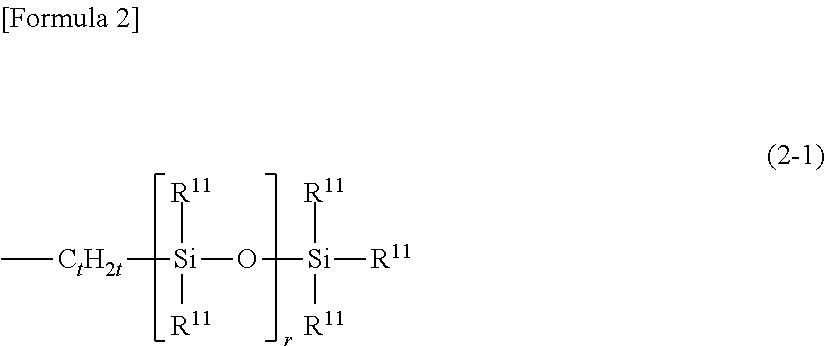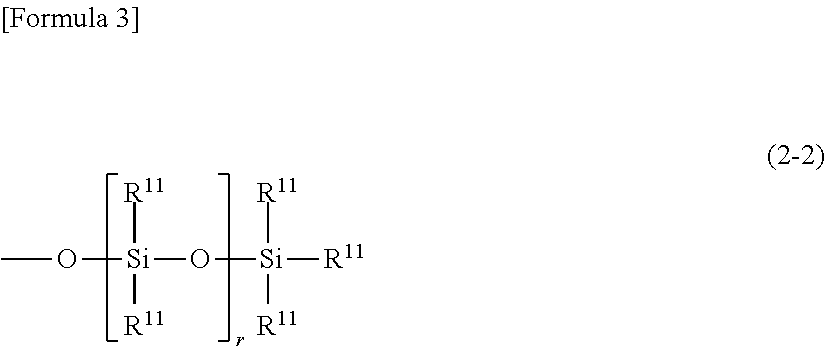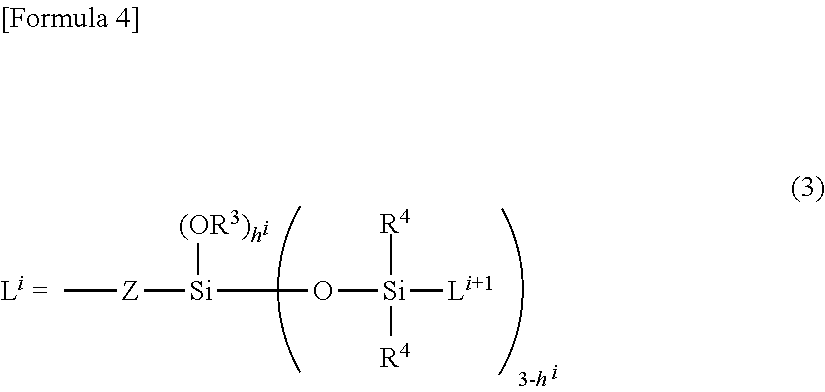Method For Producing Transparent or Semi-Transparent Liquid Glycerin-Derivative-Modified Silicone Composition
a technology of liquid glycerin and derivatives, which is applied in the direction of make-up, biocide, animal husbandry, etc., can solve the problems of low degree of freedom in structural design, low application range of polyhydric alcohol-modified silicone that is the reaction product, and low degree of freedom of polyhydric alcohol-modified silicone, etc., to achieve excellent practicality, high transparency, and stable regardless of temperature environment
- Summary
- Abstract
- Description
- Claims
- Application Information
AI Technical Summary
Benefits of technology
Problems solved by technology
Method used
Image
Examples
production example 1
Synthesis of Glycerin Derivative-Modified Silicone No. 1
[0199]Step 1: First, 401.1 g of methylhydrogenpolysiloxane represented by the average composition formula MD43.4DH7.4M, 3.5 g of vinyl tris(trimethylsiloxy)silane represented by the average composition formula CH2═CH—Si(OSiMe3)3, and 75.0 g of hexadecene (α-olefin purity=91.7%) (first time) were put into a reaction vessel and heated while stifling under a nitrogen stream. Then, 0.4 mL of a hexamethyldisiloxane solution of platinum-1,3-divinyl-1,1,3,3-tetramethyldisiloxane complex (Pt concentration 0.45 wt. %) was added, and a reaction was performed for 1 hour at 55 to 75° C. The reaction liquid was collected, and when confirmed by an alkali decomposition gas generation method (the remaining Si—H groups are decomposed using a KOH ethanol / water solution, and the reaction rate is calculated from the volume of the produced hydrogen gas), the reaction rate was as planned.
[0200]Step 2: Next, 45.7 g of diglycerin monoallyl ether, 0.07...
working example 1
Preparation of Working Example Composition 1 Containing Glycerin Derivative-Modified Silicone No. 1
[0210]First, 24.0475 g of the grayish brown opaque uniform liquid obtained in Production Example 1 (reaction mixture containing glycerin derivative-modified silicone as the main component) was collected in a 35 mL glass bottle, and 0.3679 g of purified water (equivalent to 1.53 wt. % relative to the reaction mixture) was added. When homogenization was attempted by stifling the entirety well with a stainless steel spatula for approximately 5 minutes, it was unexpectedly discovered that a nearly transparent pale brown uniform liquid was produced.
working example 2
Preparation of Working Example Composition 2 Containing Glycerin Derivative-Modified Silicone No. 1
[0211]First, 12.2 g of the nearly transparent pale brown uniform liquid obtained in Working Example 1 was collected in a 35 mL glass bottle, and 12.2 g of FZ-3196 (Dow Corning Toray Co., Ltd., caprylyl methicone) was added (equivalent to 100 wt. % relative to working example composition 1). When homogenization of the entirety was attempted by shaking, it was unexpectedly discovered that a low-viscosity slightly brown nearly transparent uniform liquid was produced.
PUM
| Property | Measurement | Unit |
|---|---|---|
| semi-transparent | aaaaa | aaaaa |
| optical path length | aaaaa | aaaaa |
| optical path length | aaaaa | aaaaa |
Abstract
Description
Claims
Application Information
 Login to View More
Login to View More - R&D
- Intellectual Property
- Life Sciences
- Materials
- Tech Scout
- Unparalleled Data Quality
- Higher Quality Content
- 60% Fewer Hallucinations
Browse by: Latest US Patents, China's latest patents, Technical Efficacy Thesaurus, Application Domain, Technology Topic, Popular Technical Reports.
© 2025 PatSnap. All rights reserved.Legal|Privacy policy|Modern Slavery Act Transparency Statement|Sitemap|About US| Contact US: help@patsnap.com



